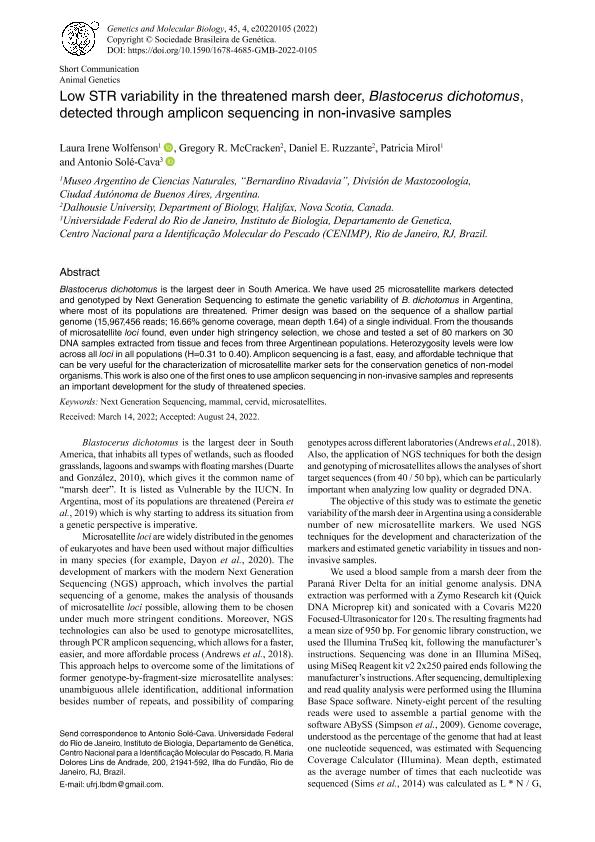Artículo
Low STR variability in the threatened marsh deer, Blastocerus dichotomus, detected through amplicon sequencing in non-invasive samples
Wolfenson, Laura Irene ; McCracken, Gregory R.; Ruzzante, Daniel E.; Mirol, Patricia Monica
; McCracken, Gregory R.; Ruzzante, Daniel E.; Mirol, Patricia Monica ; Solé Cava, Antonio
; Solé Cava, Antonio
 ; McCracken, Gregory R.; Ruzzante, Daniel E.; Mirol, Patricia Monica
; McCracken, Gregory R.; Ruzzante, Daniel E.; Mirol, Patricia Monica ; Solé Cava, Antonio
; Solé Cava, Antonio
Fecha de publicación:
11/2022
Editorial:
Sociedade Brasileira de Genética
Revista:
Genetics and Molecular Biology
ISSN:
1415-4757
e-ISSN:
1678-4685
Idioma:
Inglés
Tipo de recurso:
Artículo publicado
Clasificación temática:
Resumen
Blastocerus dichotomus is the largest deer in South America. We have used 25 microsatellite markers detected and genotyped by Next Generation Sequencing to estimate the genetic variability of B. dichotomus in Argentina, where most of its populations are threatened. Primer design was based on the sequence of a shallow partial genome (15,967,456 reads; 16.66% genome coverage, mean depth 1.64) of a single individual. From the thousands of microsatellite loci found, even under high stringency selection, we chose and tested a set of 80 markers on 30 DNA samples extracted from tissue and feces from three Argentinean populations. Heterozygosity levels were low across all loci in all populations (H=0.31 to 0.40). Amplicon sequencing is a fast, easy, and affordable technique that can be very useful for the characterization of microsatellite marker sets for the conservation genetics of non-model organisms. This work is also one of the first ones to use amplicon sequencing in non-invasive samples and represents an important development for the study of threatened species.
Palabras clave:
CERVID
,
MAMMAL
,
MICROSATELLITES
,
NEXT GENERATION SEQUENCING
Archivos asociados
Licencia
Identificadores
Colecciones
Articulos(MACNBR)
Articulos de MUSEO ARG.DE CS.NAT "BERNARDINO RIVADAVIA"
Articulos de MUSEO ARG.DE CS.NAT "BERNARDINO RIVADAVIA"
Citación
Wolfenson, Laura Irene; McCracken, Gregory R.; Ruzzante, Daniel E.; Mirol, Patricia Monica; Solé Cava, Antonio; Low STR variability in the threatened marsh deer, Blastocerus dichotomus, detected through amplicon sequencing in non-invasive samples; Sociedade Brasileira de Genética; Genetics and Molecular Biology; 45; 4; 11-2022; 1-6
Compartir
Altmétricas



